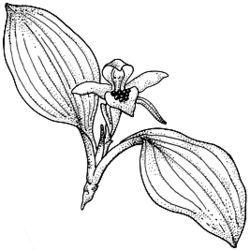Synonyms: Myrmechila D.L.Jones & M.A.Clem. APNI*
Simpliglottis Szlach. APNI*

Description: Terrestrial herbs, sympodial; roots filamentous; tuberoids paired and often also produced at apex of stolons.
Leaves basal, 2 per shoot, convolute, opposite, petiolate or sessile.
Inflorescence racemose, 1-flowered, terminal; flowers resupinate. Dorsal sepal free, broader than and about as long as, to slightly longer than lateral sepals. Lateral sepals free. Lateral petals free, slightly narrower and longer to shorter than dorsal sepal. Labellum free, attached to column foot by a short claw; lamina not lobed, with several to many calli that often form a central, insectiform aggregation. Column lacking free filament and style; column wings fused to column, linear or expansive in upper half, forming teeth at the apex that sometimes project beyond the anther. Column foot vestigial. Anther erect, persistent. Pollinia 4, soft and mealy. Stigma entire. Rostellum obscure, ventral.
Distribution and occurrence: World: c. 18 species, Australia & New Zealand. Australia: 18 species (15 species endemic), Qld, N.S.W., Vic., Tas., S.A.
We have chosen not to recognise Simpliglottis, segregated from Chiloglottis by Szlachetko (2001, Polish Botanical Journal 46: 11-26) or Myrmechila, segregated from Chiloglottis by Jones & Clements (2005, Orchadian 15: 36-37). Chiloglottis as traditionally circumscribed (i.e. as broadly circumscribed here) is a well supported monophyletic group (Clements et al. 2002, Lindleyana 17: 135-171; Mant et al. 2002, Evolution 56: 888-898) that requires no nomenclatural change at generic level.
Text by D. L. Jones
Taxon concept: D.L. Jones (1993, Flora of New South Wales vol. 4)
Taxa not yet included in identification key
Chiloglottis sphaerula
| | Key to the species | |
| 1 | Flowers broad; petals divergent, usually curved upwards in apical third | 2 |
| Flowers narrow; petals reflexed strongly against the ovary | 7 |
| 2 | Labellum more or less triangular | Chiloglottis cornuta |
| Labellum broad-ovate to cordate rarely elliptic
Back to 1 | 3 |
| 3 | Labellum elliptic | Chiloglottis x pescottiana |
| Labellum broad-ovate to cordate
Back to 2 | 4 |
| 4 | Petals linear to lanceolate, widely divergent | 5 |
| Petals broad-lanceolate, held more or less erect close to the labellum
Back to 3 | 6 |
| 5 | Flower green to yellowish green, basal calli not forming a prominent flange with labellum margin | Chiloglottis chlorantha |
| Flower reddish to purplish brown, basal calli forming a prominent flange with labellum margin
Back to 4 | Chiloglottis pluricallata |
| 6 | Flower c. 35 mm across, labellum with 1–6 calli | Chiloglottis valida |
| Flower c. 25 mm across, labellum with 20–24 calli
Back to 4 | Chiloglottis turfosa |
| 7 | Osmophores of lateral sepals less than 1 mm long, if c. 2 mm then swollen and club-like; flowers spring and summer | 8 |
| Osmophores of lateral sepals more than 2 mm long, not swollen and club-like; flowers summer, autumn and winter
Back to 1 | 11 |
| 8 | Callus confined to basal part of labellum | 9 |
| Callus extending to labellum apex
Back to 7 | 10 |
| 9 | Labellum spade-shaped, sepalline osmophores swollen and blackish | Chiloglottis palachila |
| Labellum diamond-shaped, sepalline osmophores not swollen, reddish
Back to 8 | Chiloglottis trapeziformis |
| 10 | Labellum lamina more or less horizontal, column broadly winged | Chiloglottis platyptera |
| Labellum lamina obliquely erect to erect, column narrowly winged
Back to 8 | Chiloglottis formicifera |
| 11 | Flower, including callus, wholly green, main gland shaped like a duck's head | Chiloglottis anaticeps |
| Flower greenish brown to pinkish brown, callus darker, main gland not shaped like a duck's head
Back to 7 | 12 |
| 12 | Osmophores of lateral sepals yellowish | 13 |
| Osmophores of lateral sepals reddish
Back to 11 | 14 |
| 13 | Lateral sepals more or less parallel, osmophores 7–10 mm long | Chiloglottis diphylla |
| Lateral sepals divergent, osmophores 2–3 mm long
Back to 12 | Chiloglottis sylvestris |
| 14 | Labellum margins recurved | Chiloglottis diphylla |
| Labellum margins flat
Back to 12 | 15 |
| 15 | Callus occupying most of the upper surface of the labellum, labellum apex mucronate to caudate | 16 |
| Callus occupying proximal half to two-thirds of labellum, labellum apex rounded
Back to 14 | 17 |
| 16 | Lateral sepals deflexed, osmophores 3–7 mm long, labellum apex caudate | Chiloglottis trilabra |
| Lateral sepals recurved below the labellum, osmophores 1.5–3.5 mm long, labellum apex mucronate
Back to 15 | Chiloglottis reflexa |
| 17 | Osmophores of lateral sepals 2–3 mm long | Chiloglottis sylvestris |
| Osmophores of lateral sepals 3–7 mm long
Back to 15 | 18 |
| 18 | Labellum diamond-shaped, 5–6.5 mm wide, clavate glands absent or few on callus | Chiloglottis seminuda |
| Labellum broad-spathulate, 7–8.5 mm wide, clavate glands abundant on callus
Back to 17 | Chiloglottis sphyrnoides |
|


